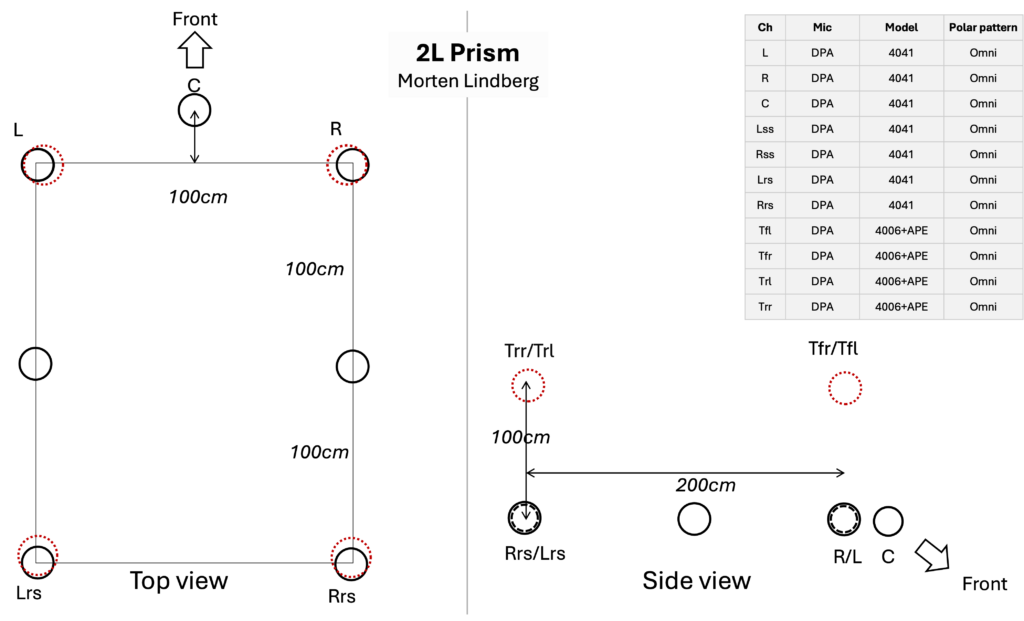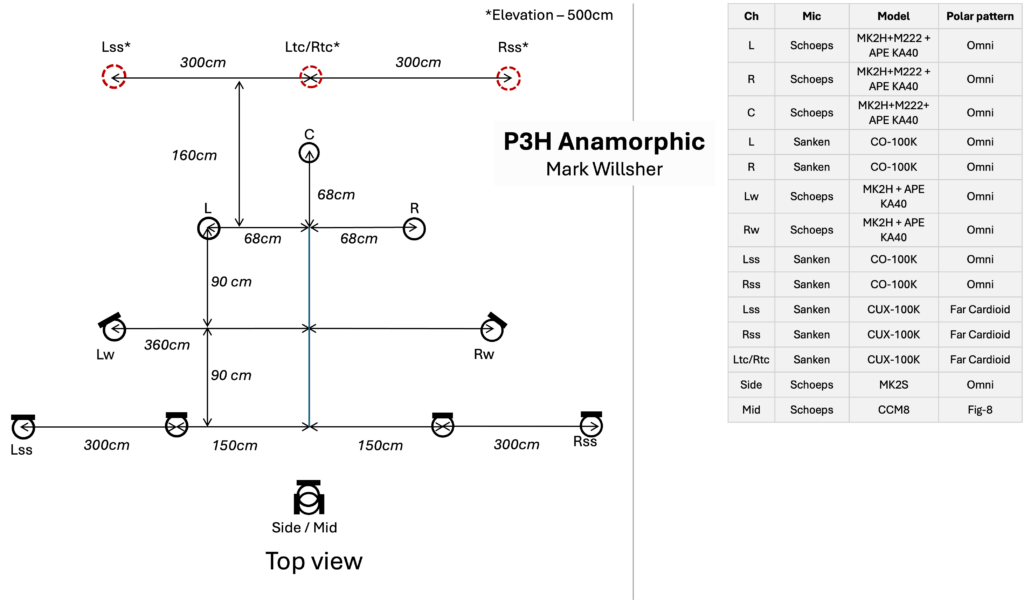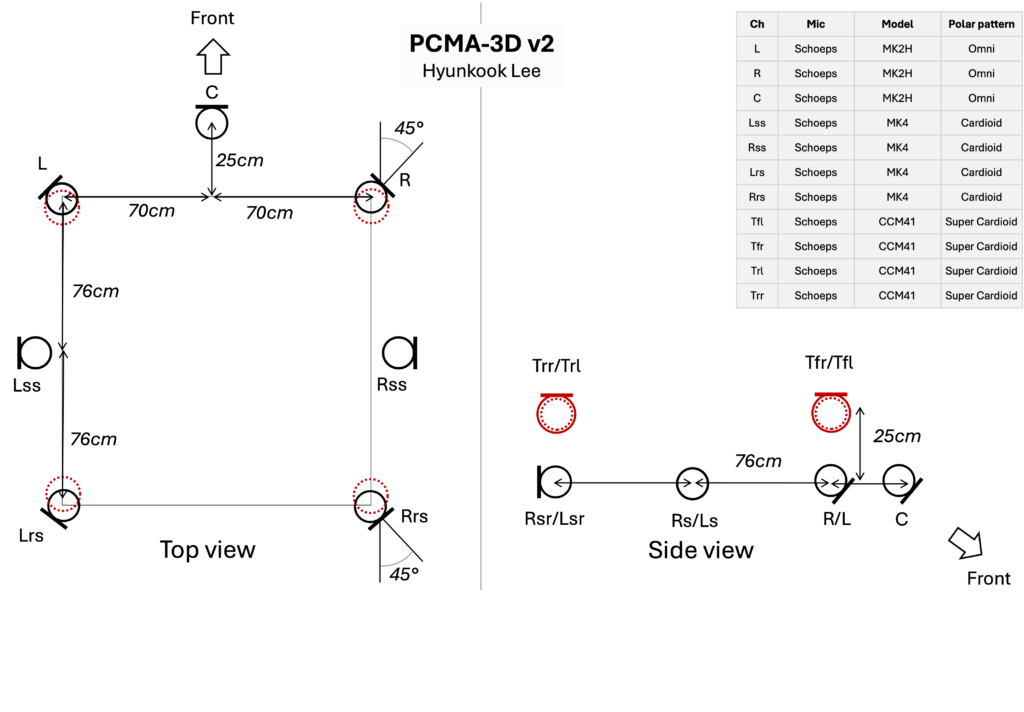Microphone Arrays
Microphone arrays are particularly important in channel-based audio, especially for capturing the acoustics of a space as well as sound sources. When properly designed, they allow for accurate spatial and tonal reproduction of sound field. The configuration of an array can be adjusted through various factors, including the type of microphone, polar pattern, spacing and angles between capsules, and finally, the placement of both the array and the musicians.
The ECHO Project invited seven expert recording engineers to explore their approaches to immersive orchestral recording. Seven microphone arrays, each tailored to a specific recording scenario—classical, film score, or game soundtrack—were used to capture the performance of the London Contemporary Orchestra in both traditional and circular layouts at AIR Lyndhurst Hall. Below, each focus group recording engineer presents their rationale behind their chosen array. Click here to find out about the orchestral setups and musical pieces recorded.
2L Prism – Morten Lindberg
Objective: Optimised level balance and transparent tonal reproduction, including low frequencies due to incorporating omnidirectional microphones, ideal for classical context especially in circular setup.
Configuration:
- Omni-directional microphones arranged in a cubic configuration that mainly relies on interchannel time difference (ICTD), mapped as discrete objects to 7.1.4 configuration.
- Acoustic pressure balls are used for height microphones to achieve higher directionality, thus introducing some interchannel level different at higher frequencies
- Ideally, all the correct balance is achieved through adjusting the positions of the musicians around the array.

AIR Cage – Nick Wollage
Objective: Spacious and enveloping sounds for traditional cinematic orchestration, characterised by the unique timbral character of Neumann M50 microphones. Offers good translation in Dolby Atmos and fold-downs.
Configuration:
- Traditional Decca Tree with M50s for L/C/R, extended with TLM170s for sides, rears and height layer.
- The use of hyper-cardioids for the TLM170s offer a greater level of interchannel decorrelation and separation, resulting in enhanced envelopment.

P3H Anamorphic – Mark Willsher
Objective: To distort the image of a traditional front-facing orchestra, and wrap it around the sides of the listener, providing greater width and envelopment, without losing forward focus. The setup is designed for theatre / film music. It offers good translation between different fold-down configurations: 7.1.4, 7.1.2, 5.1, etc.
Configuration: A Decca Tree of 680 mm from the center to capsule (Schoeps M222 MK2H KA40, with corresponding outriggers) to provide precision and focus, combined with a set of seven extended frequency response Sanken microphones for added scale and dimension. An additional E/S setup is placed in a highly diffuse area of the recording space and decoded for the rear channels – providing further realism with no distraction from the front hemisphere’s clarity (The ES may require time adjustment to achieve the desired result).
- Sankens’ off-axis response enables wider spacing without compromising tonal integrity.
- Mono higher layer capture is aimed to provide a consistent listening experience throughout a larger cinema space, but also translates well to HE. This microphone’s timbral and spatial correlation to the overhead Lss/Rss helps keep the overall image from narrowing in larger venues while still providing adequate height information.
- Audience focus remains on the central performance while they perceive good sense of envelopment and directional clarity.

ESMA-3D – Hyunkook Lee
Objectives: The Equal Segment Microphone Array 3D (ESMA-3D) is optimised for 360° sound field recordings, providing accurate and continuous imaging across all loudspeakers during reproduction and sound field rotation for head-tracked VR applications. The original ESMA concept was proposed by Michael Williams in the 1980s, and Hyunkook Lee optimised the configuration based on his MARRS ICTD/ICLD-based localisation model.
Configuration: The ESMA design concept requires: (i) the subtended angle between microphones in each stereophonic segment to match the base angle between the corresponding loudspeakers in reproduction, and (ii) the stereophonic recording angle (SRA) to match the base angle. For example, in an octagonal layout, the microphone subtended angle, loudspeaker base angle, and SRA are all 45°, while in a quadraphonic layout, they are 90°. However, the octagonal ESMA still provides good imaging across L, C, and R in a Dolby Atmos 7.1.4 loudspeaker layout. The 55 cm microphone spacing ensures sufficient decorrelation for spatial impression.
The original octagonal ESMA employs cardioid microphones for the main layer, but in the ECHO project, sub-cardioids (Schoeps MK21) were used instead to enhance low-end response. ESMA-3D extends the original ESMA by adding four cardioid microphones (Schoeps CCM4) for the height layer, arranged in a vertically coincident fashion. These height microphones face directly upwards to ensure at least 7–10 dB of channel separation, which is sufficient to prevent vertical image shift and unpleasant colouration.

PAMA – Simon Ratcliffe
Objective: Stemming from orchestral film and game music, PAMA (Prototype Atmos Microphone Array) is an in-progress design that aims to extend traditional recording configurations into the immersive space, while ensuring Dolby Atmos compatibility across theatrical and home entertainment platforms, and consecutive fold-downs and workflows typical of media score delivery.
Configuration: Anchored on a modified Decca Tree + wide pair, and extended by sides, rears and height microphones, reflecting 7-0-4/9-0-4 speaker configurations. By addressing the beds, but preserving the heights as a quad-width object, a combination of speaker arrays and front-to-back height can be addressed to extend the soundstage.
The array seeks to self-correct observed issues for theatrical and HE playback by a combination of polar patterns. 1) The use of bidirectional microphones help with the observed side-surround/surround array high load of information (especially in the lower mids) characteristic of omnidirectional microphones, we well as extending the natural ambience of the recordings through their non-directionality, and in combination with the rear super-cardioid microphones and wide channels, work well in decorrelation and provide good fold-down characteristics when delivering stereo or 5.1, as well as binaural Atmos. The height channels assigned as overhead objects, when panned 75% in from from and rear cardinal points, suitably address theatical arrays and HE systems in facilitating overhead L/R and F/R, further addressed by the rear Height mics being 10cm higher than the fronts.

PCMA-3D v2 – Hyunkook Lee
Objectives: PCMA-3D, which stands for Perspective Control Microphone Array 3D, aims to provide a natural and realistic representation of the sound field, ensuring accurate localisation and a balanced spatial impression. This design is based on key psychoacoustic principles of vertical stereophony.
Configuration: The original PCMA was designed for effective direct-to-reverberation ratio control in the 5.1 format, utilising two coincidentally arranged directional microphones at each pick-up point of the array. This concept was later adapted for 3D recording, based on experimental findings suggesting that vertical microphone spacing or vertical decorrelation has little effect on overall spatial impression. PCMA-3D, therefore, employs a horizontally spaced, vertically coincident microphone arrangement. The vertical pair is angled so that there is at least 7-10 dB of channel separation as in ESMA-3D. A supercardioid microphone (Schoeps CCM41) facing directly upwards captures the height channel, while a cardioid microphone directed towards the source ensures optimal performance. For the ECHO project, PCMA-3D v2 was used instead, featuring omnidirectional microphones (Schoeps MK2H) for the main layer (L, C, and R) to extend low-frequency response. Additionally, the height layer was positioned approximately 25 cm above the main layer, providing sufficient channel separation through decorrelation above 1 kHz.

Penta Sphere – Anthony Caruso/Kellogg Boynton
Objective: The microphones forming the array are positioned on a surface of a sphere with a radius around 1.3m, aiming for maximum coherency with spherical HRTFs used by the PS5. Additionally, the use of Neumann M50’s matches the sound of the Decca tree typically used in PlayStation’s orchestral recordings, bringing a classic score sound to the immersive array.
Configuration: All the microphones are equidistant from each other. When capturing musicians in a circular layout, the focus of the array may be rotated so that any triplet of mics can become LCR for the image, with the option of using opposing top layer mics as a .2 for Atmos mixing. Ideally the bottom mics would be all M50’s, but not having that available we chose M49’s, set to Omni for the circular layout, and cardioid for the traditional layout.

